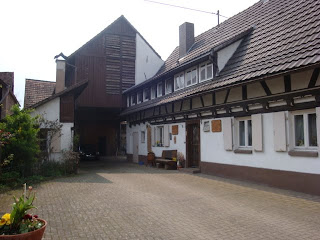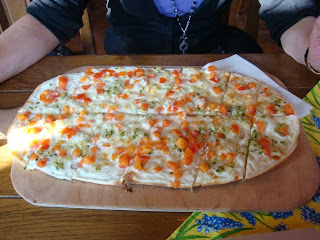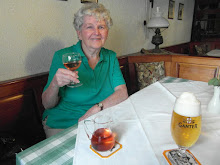
In mid March we were invited to a 60th birthday celebration. Monika had decided that for this special occasion she would invite her friends and family for a Flammenkuchen evening. Translated literally into English it means a flaming cake. It is, however, more like a pie or tart with a thin crust, baked in a very hot oven, with burning wood just below the oven in which it is baked. As with many such words in various languages, it doesn't translate well, so the original name is best.
Flammenkuchen with Grieben (crackly pork rind), at right, baking in the oven
Both in Baden-Wuerttemberg, Germany and in Alsace, France Flammenkuchen (in German) or Tartes Flambees (in French) is a specialty. In the Badisch/Alemannisch dialect, it is called Flammkuchen (sometimes Flammkuchle); in the Alsatian dialect, Flammekueche. You'll find it at almost every outdoor Fest held throughout the year. Many Gasthauses and Vesperstuben also offer it on their menus. Sometimes it will be served by the piece (at Fests) and sometimes as meal-size on a board (Gasthauses). Tonight, we knew, it would be served on several boards and with different toppings. It would be "all you can eat and drink!" We had been to this farm before, so we knew we were in for a fun evening and for more food than we could possibly eat.
A piece of Flammenkuchen with Schinken (bacon) and Zwiebeln (onions)
Herr and Frau Killius are the hosts and owners at this former farm--both of whom are heading into their 80s--and they have been doing this for quite a few years. We had been here a few times in the past--with both Canadian and German friends, including my sister, Carol, who lives in New Hampshire and was visiting us from the States.
The Killius house, below, dates back to 1696 and is one of the oldest in the town of Nonnenweier.

The house we were going to in Nonnenweier is an old half-timbered farmhouse the kind you see in the towns close to the Rhine, many of which date back to the 1700s or earlier. They are similar to those you see on the other side of the river, in Alsace, some of which go back to the 1500s. Nearly all were at one time small farms and some still are. To the side of the Killius house is a room with its own entry from outside which is used for these evenings. It is filled with long tables and benches, cases of beer and mineral water (wine is stored in the wine cellar below), a couple of counters and, tonight, flowers on the tables.
Opposite it, outside, is the bake house. The picture above shows it on the left, facing the house. The door into the "party" room is to the left of the main door of the house and left of the bench.
The plaque shows the year the house was built and then renovated: 1874, 1922, 1975 and 1994. The names of the Killius family members who renovated it are carved on the sign as well.
The picture, below right, is of the bake house, showing Frau Killius through the small window (the sign: Unser Taeglich Brot --Our Daily Bread)
Tonight, Frau Killius and her sister--who lives in the Alsace and came specifically to help--would make the Flammenkuchen for 30 of us. I went into the small stone bake house that is just off the courtyard to watch the preparations and baking. The brick oven was heating up. Flammenkuchen need a very high temperature to bake until they are crisp but not hard on the bottom and cooked through but not overdone on top. Timing is important.
The two of them were busy, whipping together the dough and rolling it out. Once the dough is rolled to the proper size and thinness, the sour cream or creme fraiche (or a combination of both) is spread over it. The toppings are added to it and it is then ready for baking. That evening we would be served an assortment, with five or six different toppings. Each Flammenkuchen would be made and baked as it was needed.
Frau Killius working with the dough and spreading the cream in the picture below it.
The crust is made from a pizza-style dough (called Brotteig in German) and rolled until very thin. (Flour in Canada and the U.S. is not suitable, though a good pizza dough recipe should work. If possible, buy some hard flour at a health food or "Country" store.) Once the Flammenkuchen is ready for the oven, a special long-handled shovel is slipped beneath it in order to slide the Flammenkuchen into the oven. The shovel is then carefully removed.
Below, the brick oven heating up (door on it closed) and two shovels--leaning against the oven--including the long-handled one
The picture below shows Frau Killius adding the Grieben (pork rind) topping
The ovens are called Holzofens, because of the burning of wood inside them (Holz is German for wood). Inside the oven floor are special flat stones on which a suitable amount of wood is placed (more added as needed) and then lit and left there until the proper temperature of the oven is reached (very hot, as high as 500F/260C). Then, the wood is pushed to the back of the stove where it drops down into a container to continue heating the oven. The baking surface is then cleaned with a specially-designed broom. It is now ready for the Flammenkuchen to be placed inside to bake (the crust is placed directly on the oven floor).
This is how bread was baked in earlier days and it still is at many farms in the Schwarzwald (Black Forest) and also at farms in small towns in this region. When seeing a sign outside a farmhouse advertising Holzofen Brot, that will be homemade bread baked in a Holzofen. Stop and buy a loaf and perhaps other homemade products as well, including Flammenkuchen (if lucky), jellies or jams.
Flames rising from below at the back of the oven with the Flammenkuchen baking and almost ready.
Flammenkuchen should bake for about ten minutes or so. Once baked, the shovel will be used to remove it from the oven. It will then be served on wooden boards. Most of these ovens are made of brick or stone and they are generally found inside small stone buildings beside or near the house. We've seen portable ones at Fests, small heavy ovens that bake well. If wishing to try baking one in North America, bake it as you would a pizza, using a very hot oven and watching it carefully.
Frau Killius' sister serving a board of Flammenkuchen. Each person takes a piece as the boards go around during the evening.
As the evening progressed, we were served one after the other of the Flammenkuchen with their various toppings. The one we loved best was the Grieben (crackly pork rind), but we liked them all, including the most common ones served everywhere: Schinken Speck (bacon bits) with thinly sliced onions, and another with Schinken Speck only. Along with all the slices of Flammenkuchen we could eat, as much wine, beer and soft drinks we could drink were available throughout the evening. As we finished the last bite of almost the last Flammenkuchen, the lights were turned out and Frau Killius, using Calvados, flambeed the Apfel Flammenkuchen, the apple dessert being a perfect ending to the meal.
Frau Killius below, readying the Apfel Flammenkuchen
Frau Killius and her sister talking to some of the guests, and underneath that picture, Herr Killius and Monika
After everyone had eaten all they possibly could, Herr and Frau Killius disappeared briefly to change their working clothes for German Trachten (traditional dress). Out came the accordion and we were treated to an hour of Herr Killius playing and Frau Killius singing. She sang mostly German folk songs but also many well-known beer garden songs, with everyone holding arms, swaying to the music and singing along, a fitting end to a lovely evening.
Herr and Frau Killius entertaining us, their guests
Flammenkuchen at Isele's Weinstube
A couple of weeks later, we joined a small group of WWII German veterans at Isele's Weinstube in Munchweier. On that occasion, I ordered Flammenkuchen topped with Muensterkaese (Munster cheese). It is, I think, both Hans' and my favourite topping. Munster cheese in North America is not the same as Muensterkaese in Europe. It may be called the same, but it is not. Here, it is a soft cheese with an orange rind and is quite odorous (to say the least!).
Below left, my Muensterkaese Flammenkuchen. On the right, a couple of us about to enjoy our choices.
 I normally am not a fan of Munster cheese (Hans loves it at any time), but as a topping and baked in the oven, it is delicious. I have it occasionally at the Kleiner Meierhof in Ettenheimweiler as well, where Sylvia and Erich also serve it. We had actually told Erich about it, as we had had it elsewhere first, and they then put it on their menu. Tonight, Sunday, where we had gone for supper, a couple near us had ordered just that.
I normally am not a fan of Munster cheese (Hans loves it at any time), but as a topping and baked in the oven, it is delicious. I have it occasionally at the Kleiner Meierhof in Ettenheimweiler as well, where Sylvia and Erich also serve it. We had actually told Erich about it, as we had had it elsewhere first, and they then put it on their menu. Tonight, Sunday, where we had gone for supper, a couple near us had ordered just that.Straussenwirtschaft and more Flammenkuchen
This past Friday evening, we joined friends at a Straussenwirtschaft that is not far from where we live. The "Strausse" is a special seasonal type of Stube. They are advertised on the road or nearby with a witch's type broom standing on its end, with the broom part itself standing upright and with streamers flying off from it to showcase it. (They are also advertised in the local papers.) When the broom is up, the "Strausse" is open. You see these brooms in Austria as well in the fall when the new wine is ready; there, the vintners' Stuben are called Heuriger.
The Straussenwirtschaft below, with Hans in the background. The broom is up and the "Strausse" is open.
Helga's shown below, with mozarella and tomato topping . This by the way is for one person!
Later, Wolfgang ordered one made with apples, though one without the Calvados flambe; instead, he ordered one with cinnamon only. I had a couple of pieces and it was delicious, sweet but not over sweet, reminiscent of apple pie with cinnamon in it.
Wolfgang's with apple and cinnamon. This is also for one, but it is easily shared as is Helga's.
Straussenwirtschaften are well worth visiting as they are usually filled with people in a great mood, dress is always casual and most of these, including the one we went to on Friday evening, are cosy, warm and filled with atmosphere. In German, the word to describe them is "gemuetlich." (Gemuetlich is another example of a single German word that would take several words in English to say the same thing.)
The only downside of the "Strausse": they do take away a lot of business from the regular Gasthauses who make their whole living in that manner, whereby the Straussenwirtschaften make their main living from farming and/or grapes. A "Strausse" is a sideline for them. Regardless, though, they are popular and they offer good food and a pleasant and memorable sojourn.
Below, an inside view of the Straussenwirtschaft we visited.
Every table was taken. Hans is at the bar to buy a loaf of their homemade bread.






















Hi Janet,
ReplyDeleteI think my comment addressed to your blog about Flammenkuchen will be posted on your blog before this one. I'm not sure what happened.
In the meantime I have thought of another question after looking closer at your pictures. How do they manage to keep the old farmhouses in such a good state? The one in Nonnenweirer looks so good! It amazes me.
Saby
Hi Saby, The houses were very well built in the beginning and future generations then looked after them. People didn't build homes as easily in those days, so a house built was meant to be handed down to the next generation and onwards. From time to time, as shown on my blog picture of a plaque, they do renovations, which could entail new wooden planks inside, wiring (none when it was first built)and other renewals.
ReplyDelete